Zeitschriftenartikel, Buchbeiträge und Bücher
- Zompro, O. 2019 -- Die Bettwanzen-Fibel. -- Sungaya-Verlag, Berlin. 208 S. ISBN 978-3-943592-20-7.
- Zompro, O. 2019 -- Über ein außergewöhnliches Nest der Gemeinen Wespe, Vespula vulgaris. -- ARTHROPODA n.s. 1: 69-82.
- Zompro, O. 2018 -- Ein Absauggerät für Insekten auf gesundheitlich bedenklichen Substraten. -- ARTHROPODA n.s. 1: 61-67.
- Zompro, O. 2017 -- Selbstbau eines Terrariums für kleinere Rosenkäfer. -- ARTHROPODA n.s. 1: 15-19.
- Zompro, O. 2017 -- Periphetes forcipatus, eine farbenfrohe Stabschrecke. -- ARTHROPODA n.s. 1: 21-25.
- Zompro, O. 2017 -- Bettwanzen - eine Plage kehrt zurück. -- Online Aquarium Magazin 100: 23-28.
- Zompro, O. 2016 -- Bettwanzen als Krankheitsüberträger? Ich sage: sehr wahrscheinlich. -- Der praktische Schädlingsbekämpfer 01/2016: 14-15.
- Zompro, O. 2014 -- Mitteleuropäische Sumpfdeckelschnecken – Beobachtungen im Freien und im Aquarium. -- AKFS-aktuell 30: 4-11.
- Zompro, O. 2012 -- Grundwissen Phasmiden Biologie, Haltung, Zucht. -- Sungaya-Verlag, Berlin. 80 S. ISBN 978-3-943592-00-9.
- Zompro, O. 2012 -- Zeitzeuge der Dinosaurier - Triops cancriformis, der Sommer-Schildkrebs. -- AKFS-aktuell 30: 16-23.
- Zompro, O. 2011 -- Seltener Gast aus Kubas Höhlen. -- DATZ 09/2011: 14.
- Zompro, O. & Fallaschinski, N. 2011 -- Mit Vorsicht zu genießen: Die Schnappschildkröte Chelydra serpentina. -- AKFS-aktuell 19: 25-30.
- Zompro, O. 2011 -- Ein neu eingeschleppter Flußkrebs aus Australien - Cherax quadricarinatus, der Rotscherenkrebs. -- AKFS-aktuell 19: 27-29.
- Zompro, O. 2011 -- Description of the first adult female of †Archipseudophasma phoenix Zompro, 2001 known to science, with notes on the subfamily †Sucinophasmatinae (Insecta: Phasmatodea: †Archipseudophasmatidae). -- ARTHROPODA Generalis 2: 1-9.
- Zompro, O. 2009 -- Buchvorstellung Exotiske Insekter herausgegeben von Foreningen Exotiske Insekter. -- ARTHROPODA 17(2): 99.
- Zompro, O. 2009 -- Buchvorstellung Die Fauna der Nordsee Niedere Tiere I von Sven Gehrmann (2008). -- ARTHROPODA 17(2): 99.
- Zompro, O. 2009 -- Buchvorstellung Flußkrebse Biologie-Ökologie-Gefährdung von Leopold Füreder (2009). -- ARTHROPODA 17(2): 99.
- Zompro, O. 2009 -- Buchvorstellung Der Laubfrosch von Wolf-Rüdiger Grosse (2008). -- ARTHROPODA 17(2): 98.
- Zompro, O. 2009 -- Buchvorstellung Lyby-Strand Fossilien Schätze aus Dänemarks Limfjordgebiet von Axel Cordes & Dirk Dettmers (2009). -- ARTHROPODA 17(2): 98.
- Zompro, O. 2009 -- Buchvorstellung The Crato Fossil Beds of Brazil Window into an ancient world herausgegeben von David M. Martill, Günther Bechly & Robert F. Loveridge (2007). -- ARTHROPODA 17(2): 98.
- Zompro, O. 2009 -- Einführung in die zoologische Nomenklatur. -- ARTHROPODA 17(2): 94-97.
- Zompro, O. 2009 -- Sulawesi-Garnelen bekommen Namen. -- ARTHROPODA 17(2): 93.
- Zompro, O. 2009 -- Die Präparation von Käfern. -- ARTHROPODA 17(2): 86-89.
- Zompro, O. 2009 -- Die Harlekingarnele, ein spezialisierter Seesternfresser. -- ARTHROPODA 17(2): 82-85.
- Zompro, O. & Gruber, M. 2009 -- Rhithropanopeus harrisii, die Zuidersee oder Zwergkrabbe. -- ARTHROPODA 17(2): 74-77.
- Zompro, O. & Köhn, J. 2009 -- Ein Blattkäfer im heimischen Brackwasser. -- ARTHROPODA 17(2): 72-73.
- Rossow, F. & Zompro, O. 2009 -- Vampirkrabbe, Mandarinkrabbe und Verwandte - Gattung Geosesarma de Man, 1892. -- ARTHROPODA 17(2): 42-51.
- Zompro, O. 2009 -- Fangschrecken im Baltischen Bernstein. -- ARTHROPODA 17(2): 4.
- Zompro, O. 2009 -- Mantophasmatodea - Erster Nachweis aus dem Jura. -- ARTHROPODA 17(2): 5.
- Zompro, O. 2009 -- Fangschrecken im Baltischen Bernstein. -- ARTHROPODA 17(2): 4.
- Zompro, O. 2009 -- Neuimporte und Besonderheiten. -- ARTHROPODA 17(1): 100.
- Zompro, O. 2009 -- Buchvorstellung Die Afrikanische Riesenschnecke Achatina (Lissachatina) fulica von Heiko Schultz & Robert Nordsieck (2008). -- ARTHROPODA 17(1): 99.
- Zompro, O. 2009 -- Buchvorstellung Der Karpfen von Werner Steffens (2008). -- ARTHROPODA 17(1): 98.
- Zompro, O. 2009 -- Buchvorstellung Die Amphibien und Reptilien Portugals, Madeiras und der Azoren von Rudolf Malkmus (2008). -- ARTHROPODA 17(1): 98.
- Zompro, O. 2009 -- Namensänderung bei Tridacna-Riesenmuschel. -- ARTHROPODA 17(1): 95.
- Zompro, O. 2009 -- Präparation von Phasmiden. -- ARTHROPODA 17(1): 92-93.
- Zompro, O. 2009 -- Das längste Lebewesen - ein Bewohner der Nordsee. -- ARTHROPODA 17(1): 81.
- Zompro, O. 2009 -- Die Chinesische Teichmuschel Sinanodonta woodiana. -- ARTHROPODA 17(1): 68-69.
- Zompro, O. 2009 -- Der Marmorkrebs Procambarus sp. -- ARTHROPODA 17(1): 66.
- Zompro, O. & Prescott, T. 2009 -- Notes on Megacrania nigrosulfurea Redtenbacher, 1908 (Phasmatodea: Platycraninae). -- ARTHROPODA 17(1): 44-45.
- Zompro, O. 2009 -- Ctenomorphodes sp. aus Neu-Guinea - eine geflügelte Riesenstabschrecke. -- ARTHROPODA 17(1): 42-43.
- Zompro, O. 2009 -- Paragongylopus plaumanni Zompro, 2000 - eine der merkwürdigsten Phasmiden. -- ARTHROPODA 17(1): 20-21.
- Zompro, O. 2009 -- Stabschrecke, Gespenschrecken, Wandelnde Blätter - Phasmidensystematik im Überblick I. -- ARTHROPODA 17(1): 10-18.
- Zompro, O. 2009 -- Schon gewusst? - Bemerkenswertes über Phasmiden. -- ARTHROPODA 17(1): 8-9.
- Zompro, O. 2009 -- Ausgestorbene Riesenschnecken in Europa. -- ARTHROPODA 17(1): 6-7.
- Zompro, O. 2009 -- Evolution oder Kreationismus - Wissenschaft oder Glaube? -- ARTHROPODA 17(1): 3-4.
- Fritzsche, I. & Zompro, O. 2008 -- A new species of Therea Billberg, 1820 from India (Blattodea: Polyphagidae). -- ARTHROPODA 16(4): 20-21.
- Zompro, O. 2008 -- Buchvorstellung Die Schildläuse von Heinrich Schmutterer (2008). -- ARTHROPODA 16(4): 100-101.
- Zompro, O. 2008 -- Buchvorstellung Aqualog Jahrbuch 2009 aus dem Aqualog Verlag (2008). -- ARTHROPODA 16(4): 100.
- Zompro, O. & Fritzsche, I. 2008 -- Riesenkäfer. -- ARTHROPODA 16(4): 4-5.
- Zompro, O. 2008 -- Die längste Stabschrecke - das längste lebende Insekt. -- ARTHROPODA 16(4): 6-7.
- Zompro, O. 2008 -- Attacus atlas (LINNAEUS, 1758), der Atlasspinner. -- ARTHROPODA 16(4): 8-12.
- Fritzsche, I. & Zompro, O. 2008 -- A new species of Therea Billberg, 1820. -- ARTHROPODA 16(4): 20-21.
- Zompro, O. 2008 -- Die größte Süßwassermuschel - Cristaria herculea. -- ARTHROPODA 16(4): 44-45.
- Zompro, O., Gruber, M. & Fritzsche, I. 2008 -- Riesenmuscheln - Mythen, Realität und Evolution. -- ARTHROPODA 16(4): 60-95.
- Zompro, O. 2008 -- Buchvorstellung Die Falkenlibellen Europas von Hansruedi Wildermuth (2008). -- ARTHROPODA 16(3): 100.
- Zompro, O. 2008 -- Buchvorstellung Die Hirschkäfer von Bernhard Klausnitzer und Eva Sprecher-Übersax (2008). -- ARTHROPODA 16(3): 99-100.
- Zompro, O. 2008 -- Buchvorstellung Wandelnde Blätter von Detlef Größer (2008). -- ARTHROPODA 16(3): 99.
- Zompro, O. 2008 -- Buchvorstellung Terrarien bauen und einrichten von Friedrich Wilhelm Henkel & Wolfgang Schmidt (2008). -- ARTHROPODA 16(3): 98.
- Zompro, O. 2008 -- Buchvorstellung Arthropods in Baltic Amber von Jens-Wilhelm Janzen (2002). -- ARTHROPODA 16(3): 98.
- Zompro, O. 2008 -- Buchvorstellung Leben mit Vogelspinnen von Karin Manns (2008). -- ARTHROPODA 16(3): 97.
- Zompro, O. 2008 -- Buchvorstellung Fische, Krebse, Muscheln in heimischen Seen und Flüssen Wolfgang Hauer (2007). -- ARTHROPODA 16(3): 96-97.
- Zompro, O. 2008 -- Man redet ja nicht gerne darüber ... für Anfänger ... unwissenschaftlich ... kindisch ... -- ARTHROPODA 16(3): 94-95.
- Zompro, O. 2008 -- Zu Besuch im ,Haus der Natur‘ in Cismar. -- ARTHROPODA 16(3): 82-87.
- Zompro, O. & Kujawski, T. 2008 -- Morphologie und Anatomie I: Süßwassermuscheln. -- ARTHROPODA 16(3): 80-81.
- Zompro, O. 2008 -- Weichtiere im Süß- und Brackwasseraquarium: Schnecken 2. -- ARTHROPODA 16(3): 64-67.
- Zompro, O. & Fritzsche, I. 2008 -- Weichtiere im Süß- und Brackwasseraquarium: Muscheln. -- ARTHROPODA 16(3): 54-63.
- Zompro, O. 2008 -- Die spinnen, die Aquarianer - Spinnen für Aquarianer? -- ARTHROPODA 16(3): 50-52.
- Zompro, O. 2008 -- Schneckenimporte - doch was kommt da eigentlich. -- ARTHROPODA 16(3):47.
- Zompro, O. 2008 -- Zwergformen der Phasmatodea - die Kleinsten unter den Riesen. -- ARTHROPODA 16(3): 28-32.
- Zompro, O. 2008 -- Ausgestorbene exotische Insekten in Europa. -- ARTHROPODA 16(3): 4-5.
- Huang, D.-Y., Nel, A., Zompro, O. & Waller, A. 2008 -- Mantophasmatodea now in the Jurassic. -- Naturwissenschaften 95(10): 947-952.
- Zompro, O. 2008 -- Field guide to insects of South Afrika von Mike Picker, Charles Grifith und Alan Weaving (2004). -- ARTHROPODA 16(2): 96.
- Zompro, O. 2008 -- Das Insektenhotel von Richard Günzel (2008). -- ARTHROPODA 16(2): 97.
- Zompro, O. 2008 -- Alles über Garnelen Krebse & Krabben im Süß- und Brackwasseraquarium und Paludarium von Uwe Werner (2008). -- ARTHROPODA 16(2): 97.
- Zompro, O. 2008 -- Nacktschnecken der Weltmeere von Rudie H. Kuiter und Helmut Debelius (2007). -- ARTHROPODA 16(2): 98.
- Zompro, O. 2008 -- Das Meerwasseraquarium von Dieter Brockmann (2008). -- ARTHROPODA 16(2): 98.
- Zompro, O. 2008 -- Buchvorstellung Afrikanische Riesenschnecken Haltung Pflege Zucht von Tanja Daniel (2006). -- ARTHROPODA 16(2): 100.
- Zompro, O. 2008 -- Ein großer Leuchtkäfer aus Japan. -- ARTHROPODA 16(2): 88.
- Zompro, O. 2008 -- Cambarellus (Pandicambarus) texanus Albaugh & Black, 1973. -- ARTHROPODA 16(2): 87.
- Zompro, O. & Fritzsche, I. 2008 -- Weichtiere im Süß- und Brackwasseraquarium Teil 1: Schnecken. -- ARTHROPODA 16(2): 56-71.
- Zompro, O. 2008 -- Zur Entdeckung von Sungaya inexpectata Zompro, 1996. -- ARTHROPODA 16(2): 41.
- Fritzsche, I., Zompro, O., & Adis, J. 2008 -- A remarkable "ancient" cockroach from Brazil (Insecta: Oothecariformia: Blattodea: Blattidae: Cryptocercinae). -- ARTHROPODA 16(2): 34-37.
- Zompro, O. 2008 -- Ein Hotel für Insekten. -- ARTHROPODA 16(2): 17.
- Zompro, O. & Kujawski, T. 2008 -- ,Schnecken'-Fossilien - eine kurze Reise durch die Zeit. -- ARTHROPODA 16(2): 6-9.
- Zompro, O. 2008 -- Antiquarisches Rana Rumpetroll von Eli Quisling (1935). -- ARTHROPODA 16(1): 90.
- Zompro, O. 2008 -- Buchvorstellung Bildatlas der Farn- und Blütenpflanzen Deutschlands (2007). -- ARTHROPODA 16(1): 89.
- Zompro, O. 2008 -- Buchvorstellung Handbook of European Freshwater Fishes von Maurice Kottelat & Jörg Freyhof (2007). -- ARTHROPODA 16(1): 88.
- Zompro, O. 2008 -- Buchvorstellung Fishes of the World von Joseph S. Nelson (2007). -- ARTHROPODA 16(1): 88.
- Zompro, O. 2008 -- Tellerschnecken auf Tylomelania-Arten. -- ARTHROPODA 16(1): 78.
- Fritzsche, I. & Zompro, O. 2008 -- Neue Süßwassergarnelen aus Sulawesi. -- ARTHROPODA 16(1): 76.
- Zompro, O. 2008 -- Urticina felina (Linnaeus, 1758) - Die verfressene Erdbeerrose. -- ARTHROPODA 16(1): 68-69.
- Zompro, O. & Fritzsche, I. 2008 -- Kleinaquarien für Süßwasser-Wirbellose - Aquarientechnik und Zubehör. -- ARTHROPODA 16(1): 52-55.
- Zompro, O. & Fritzsche, I. 2008 -- A new phasmid from Cuba - Malacomorpha guamuhayaense n. sp. (Phasmatodea: Pseudophasmatidae). -- ARTHROPODA 16(1): 36-37.
- Zompro, O. 2008 -- †Raptophasma groehni n. sp., a new species of gladiator from Baltic amber (Insecta: Mantophasmatodea: Mantophasmatidae). -- ARTHROPODA 16(1): 26-27.
- Zompro, O. 2008 -- Mantophasmatodea - Gladiatoren im Insektenreich. -- ARTHROPODA 16(1): 4-25.
- Zompro, O. 2008 -- Buchvorstellung Libellen Österreichs von Rainer Raab, Andreas Chovanec & Josef Pennerstorfer. -- ARTHROPODA 15(1/2): 35.
- Zompro, O. & Fritzsche, I. 2008 -- Cherax holthuisi Lukhaup & Pekny, 2006 - Jetzt auch in schwarz. -- ARTHROPODA 15(3): 31.
- Zompro, O. & Fritzsche, I. 2008 -- Rennschnecken - Vittina sp.. -- ARTHROPODA 15(3): 28.
- Zompro, O. & Fritzsche, I. 2008 -- Birgus latro Linnaeus, 1767 - Der Palmendieb. -- ARTHROPODA 15(3): 26.
- Zompro, O. 2008 -- 15 Jahre ARTHROPODA. -- ARTHROPODA 15(3): 8-25.
- Zompro, O. 2008 -- Zur Geschichte der ZAG. -- ARTHROPODA 15(3): 4-6.
- Zompro, O. 2007 -- Antiquarisches Anleitung zur Haltung und Beobachtung Wirbelloser Tiere von Cornell Schmitt (1921). -- ARTHROPODA 15(1/2): 47.
- Zompro, O. 2007 -- Süßwassergarnelen aus aller Welt von Andreas Karge und Werner Klotz (2007). -- ARTHROPODA 15(1/2): 46.
- Zompro, O. 2007 -- Buchvorstellung Garnelenfibel Süßwassergarnelen für Anfänger und Fortgeschrittene von Carsten und Frank Logemann (2006). -- ARTHROPODA 15(1/2): 45.
- Zompro, O. 2007 -- Buchvorstellung Die Mottenschildläuse Aleyrodina Pflanzensaftsaugende Insekten - Band 2 von Rudolf Bährmann (2002). -- ARTHROPODA 15(1/2): 43.
- Zompro, O. 2007 -- Buchvorstellung Fishes of the World von Joseph S. Nelson (2006). -- ARTHROPODA 15(1/2): 43.
- Zompro, O. 2007 -- Galloisiana (Galloisiana) yuasai Asahina, 1959 - Grylloblattodea. -- ARTHROPODA 15(1/2): 41.
- Zompro, O. 2007 -- Thiara scabra (Müller, 1774) - Stachlige Turmdeckelschnecke. -- ARTHROPODA 15(1/2): 39.
- Zompro, O. 2007 -- Der Marmorkrebs. -- AKFS-aktuell 19: 8-9.
- Fritzsche, I. & Zompro, O. 2007 -- Die Teppich-Stabschrecke (PSG 173) - Neohirasea maerens (Brunner v. Wattenwyl, 1907). -- ARTHROPODA 15(1/2): 34-36.
- Fritzsche, I. & Zompro, O. 2007 -- Pseudoproscopia scabra (Klug, 1829) - die Pferdekopfschrecke (Saltatoria: Caelifera: Proscopiidae: Proscopiinae). -- ARTHROPODA 15(1/2): 28-33.
- Zompro, O. & Fritzsche, I. 2007 -- Nachruf Prof. Dr. Joachim Ulrich Adis *04.März 1950 - †29.August 2007. -- ARTHROPODA 15(1/2): 4-5.. --
- Bragg, P. E & Zompro, O. 2007 -- Biographies of phasmatologists - 6. Klaus Günther. -- Phasmid Studies 16(2): 25-33.
- Zompro, O. 2007 -- Revision of Oncotophasma Rehn (Insecta: Phasmatodea: Diapheromeridae). -- Stuttgarter Beiträge zur Naturkunde Serie A 703: 1-25.
- Zompro, O. 2007 -- A replacement name for Microphasma Zompro, 1999 -- Phasmid Studies 15(1&2): 10.
- Zompro, O. 2007 -- Zwergkrabben. -- VDA-aktuell 13(2): 21.
- Zompro, O. 2007 -- Merkwürdiges Verhalten beim Kolbenwasserkäfer. -- ARTHROPODA 14(3/4): 32-33.
- Fritzsche, I. & Zompro, O. 2007 -- Die Schnauzenschnecke Bithynia tentaculata (Linnaeus, 1758) - ein interessanter Aquarienpflegling. -- ARTHROPODA 14(3/4): 28-31.
- Zompro, O. 2007 -- A new species of Lonchodes Gray, 1835 from the Philippine Islands (Insecta: Phasmatodea: Lonchodinae). -- ARTHROPODA 14(3-4): 11-14.
- Zompro, O. 2007 -- Die Schwierigkeiten der Erstellung einer ARTHROPODA. -- ARTHROPODA 14(3/4): 10.
- Zompro, O. 2007 -- Historische Schädlinge - Der Große Eichenheldbock und der Buchenspießbock. -- Der praktische Schädlingsbekämpfer 59(3): 20-21.
- Zompro, O. 2007 -- Stadtpark Belem Alienalarm! -- VDA-aktuell 14(1): 26.
- Zompro, O. & Adis, J. 2006 -- Notes on Namibian Mantophasma Zompro, Klass, Kristensen & Adis, 2002, with descriptions of three new species (Insecta: Mantophasmatodea: Mantophasmatidae: Mantophasmatini). -- Russian Entomological Journal 15(1): 21-24.
- Zompro, O., Adis, J. & Berti-Filho, E. 2006 -- The first Australian record of a species of Echetlus originally described from Brazil (Phasmatodea: Verophasmatodea: "Anareolatae"). -- Studies on Neotropical Fauna and Environment 41(2): 131-132.
- Zompro, O. 2006 -- Katalog des Typen-Materials der Insektenordnung Phasmatodea im Staatlichen Museum für Naturkunde in Stuttgart. -- ARTHROPODA 13(4): 2-15.
- Zompro, O. 2005 -- Haplopus Burmeister, 1838, replacement name for Aplopus Gray, 1835 (Phasmatodea). -- Phasmid Studies 13(1&2): 30.
- Zompro, O. 2005 -- Catalogue of the type material of the insect order Phasmatodea, housed in the Museum für Naturkunde der Humboldt-Universität zu Berlin, Germany, and in the Institut für Zoologie der Martin-Luther-Universität in Halle (Saale, Germany. -- Mitteilungen aus dem Museum für Naturkunde in Berlin, Deutsche entomologische Zeitschrift 52(2): 251-290.
- Zompro, O. 2005 -- Inter- and intra-ordinal relationships of the Mantophasmatodea, with comments on the phylogeny of polyneopteran orders (Insecta: Polyneoptera). -- Mitteilungen aus dem Geologisch-Paläontologischen Institut der Universität Hamburg 89: 85-116.
- Zompro, O. 2005 -- The first records of Korinnis Günther, 1932 from Thailand and from the Philippines, and the description of a new species of Pharnacia Stål, 1877 (Insecta: Phasmatodea). -- Entomologische Zeitschrift, Stuttgart 115(2): 71-74.
- Zompro, O. & Fritzsche, I. 2005 -- Gibt es keimende Phasmideneier? - Ein Preisrätsel. -- ARTHROPODA 13(1): 30-32.
- Zompro, O. 2005 -- A key to the stick insect genera pf the 'Anareolatae' of the New World, with descriptions of several new taxa (Insecta: Phasmatodea). -- Studies on Neotropical Fauna and Environment 39(2): 133-144.
- Zompro, O. 2005 -- A key to the genera of the Phasmatodea: Areolatae (Insecta). -- Phasmid Studies 12(1&2): 11-24.
- Zompro, O. & de Domenico, F. C. 2005 -- Catalogue of the type material of Phasmatodea (Insecta) deposited in Brazilian Museums. -- Iheringia. Série Zoologia 95(3): 255-259.
- Zompro, O. 2004 -- Johann Jakob Kaup as the founder of phasmatodea ootaxonomy. -- Kaupia. Darmstädter Beiträge zur Naturgeschichte 13: 89-97.
- Zompro, O. 2004 -- Revision of the genera of the Areolatae, including the status of Timema and Agathemera (Insecta: Phasmatodea). -- Abhandlungen des Naturwissenschaftlichen Vereins
in Hamburg (NF) 37: 1-327. - Zompro, O. 2004 -- Prisopus wolfgangjunki n. sp., a new species of Prisopus St. Fargeau & Audinet-Serville, 1827, from Brazil (Phasmatodea: Prisopodidae). -- Amazoniana 17(3/4): 509-511.
- Zompro, O. 2003 -- Catalogue of the type material of the insect order Phasmatodea at the Zoologisches Museum der Universität Hamburg (Insecta: Orthptera: Phasmatodea). -- Mitteilungen aus dem Hamburgischen Zoologischen Museum und Institut 99: 179-201.
- Klass, K.-D., Zompro, O., & Adis, J. U. 2003 -- Ordnung Mantophasmatodea. -- In H. H. Dathe (Hrsg.) 2003 -- Insecta. -- Spektrum Akademischer Verlag.
- Zompro, O. & Größer, D. 2003 -- A generic revision of the insect order Phasmatodea: The genera of the areolate stick insect family Phylliidae (Walking Leaves). -- Spixiana 26(2): 129-141.
- Zompro, O. & Adis, J. 2003 -- Mantophasmatodea: Zur Entdeckung einer neuen Insektenordnung mit einer fossilen Art aus dem Baltikum und rezenten Arten aus Afrika. -- Verhandlungen / Westdeutscher Entomologentag 2002: 53-62.
- Zompro, O., Adis, J. & Weitschat, W. 2003 -- A review of the Order Mantophasmatodea (Insecta). -- Zoologischer Anzeiger 241: 269-279.
- Zompro, O. & Brock, P. D. 2003 -- Catalogue of type-material of stick-insects housed in the Museum d'histoire naturelle, Geneva, with descriptions of some new taxa (Insecta: Phasmatodea). -- Revue suisse de zoologie 110(1): 3-43.
- Zompro, O., Adis, J., Bragg, P. E., Naskrecki, P., Meakin, K., Wittneben, M. & Saxe, V. 2003 -- A new genus and species of Mantophasmatidae (Insecta: Mantophasmatodea) from the Brandberg Massif, Namibia, with notes on behaviour. -- Cimbebasia 19: 13-24.
- Zompro, O. 2002 -- Catalogue of the type-material of the insect order Phasmatodea deposited in the Museum für Tierkunde, Dresden, Germany. -- Phasmid Studies 11(2): 31-44.
- Zompro, O. 2002 -- Mantophasmatodea, eine neue Insektenordnung. -- Kieler Sprotte 38: 14-38.
- Zompro, O. 2002 -- Designation of type species of several genera of Phasmatodea: Areolatae. -- ARTHROPODA 10(2): 5-8.
- Zompro, O. 2002 -- Spinohirasea crassithorax, n. gen. n. sp., eine neue Stabschrecke aus Vietnam (Phasmatodea: Phasmatidae: Lonchodinae: Menexenini). -- Bonner zoologische Beiträge 50(1-2): 67-72.
- Adis, J. & Zompro, O. 2002 -- Unknown insect order found in Namibia, and shortly before in a piece of 45 million-year-old amber. -- What's up? Newsletter of the International Canopy Network 8(4): 3-4.
- Zompro, O., Adis, J., Moombolah-Goagoses, E. & Marais, E. 2002 -- Gladiatoren: Gespenstische Räuber. -- Gladiatoren: Gespenstische Räuber. -- Spektrum der Wissenschaft 64-69.
- Klass, K.-D., Zompro, O., Kristensen, N. P., & Adis, J. 2002 -- Mantophasmatodea: A new insect order with extant members in the afrotropics. -- Science 296(5572): 1456-1459.
- Zompro, O. 2002 -- A revision of Oreophoetes Rehn, 1904, and a description of a new genus (Insecta: Phasmatodea: Anareolatae: Diapheromeridae: Diapheromerinae: Oreophoetini). -- Revue suisse de Zoologie 109(1): 143-153.
- Zompro, O. & Adis, J. 2001 -- A new species of Phasmatodea of the genus Echetlus Stål. -- Revista de agricultura, Piracicaba 76(2): 291-297.
- Zompro, O. 2001 -- Redescription and new synonymies of Heteronemia Gray, 1835 (Insecta: Phasmatodea) transferred to the suborder Areolatae. -- Studies on Neotropical Fauna and Environment 36(3): 221-225.
- Zompro, O. & Eusebio, O. 2001 -- A new genus and species of stick insect (Phasmatodea: Heteronemiidae: Lonchodinae) from the Philippine islands. -- Philippine Entomologist 15(1): 23-26.
- Zompro, O. & Hennemann, F. 2001 -- A new species of Autolyca Stål, 1875 from El Salvador (Phasmatodea: Pseudophasmatidae, Anisomorphini). -- Nachrichten des entomologischen Vereins Apollo N. F. 22(3): 175-176.
- Zompro, O. 2001 -- The type-material of the insect order Phasmatodea, described by Johann Jacob Kaup (Insecta: Phasmatodea). -- Senckenbergiana biologica 81(1/2): 133-145.
- Zompro, O. 2001 -- Note. -- Phasmid Studies 10(1&2): 49.
- Zompro, O. 2001 -- Stick insects in Baltic Amber. -- Phasmid Studies 10(2): 41-44.
- Zompro, O. 2001 -- Caledoniophasma marshallae, a new genus and species of Phasmatodea. -- Phasmid Studies 10(2): 29-33.
- Zompro, O. 2001 -- The Phasmatodea and Raptophasma n. gen., Orthoptera incertae sedis, in Baltic amber (Insecta: Orthoptera). -- Mitteilungen aus dem Geologisch-Paläontologischen Institut der Universität Hamburg 85: 229-261.
- Zompro, O. 2001 -- Phyllium (Pulchriphyllium) exsectum n. sp. – In: Größer, D. 2001 -- Wandelnde Blätter. Ein Katalog aller bisher beschriebenen Phylliinae-Arten und deren Eier mit drei Neubeschreibungen. -- Edition Chimaira. 119 S.
- Zompro, O. 2001 -- Philippine phasmids from the collexction of the Staatliches Museum für Tierkunde, Dresden (Insecta: Phasmatodea). -- Reichenbachia 34(5): 49-56.
- Zompro, O. 2001 -- A review of Eurycanthinae: Eurycanthini, with a key to genera, notes on the subfamily and designation of type species. -- Phasmid Studies 10(1): 19-23.
- Zompro, O. 2001 -- A new species of Phanocles from Ecuador (Phasmatodea: Diapheromeridae: Diapheromerinae: Diapheromerini). -- Phasmid Studies 10(1): 17-18.
- Zompro, O. 2001 -- Note on Pseudodiacantha macklottii (de Haan). -- Phasmid Studies 10(1): 15-16.
- Zompro, O. 2001 -- A generic revision of the insect order Phasmatodea: The New World genera of the stick insect subfamily Diapheromeridae: Diapheromerinae = Heteronemiidae: Heteronemiinae sensu Bradley & Galil, 1977. -- Revue suisse de Zoologie 108(1): 189-255.
- Zompro, O. & Eusebio, O. 2000 -- A new species of stick insect (Phasmatodea: Heteropterygidae: Obriminae: Obrimini) from Cebu Island, Philippines. -- Philippine Entomologist 14(2): 131-135.
- Zompro, O. 2000 -- Designation of type-species of 13 stick-insect genera described by J. Redtenbacher (Insecta: Orthoptera): Phasmatodea). -- Annales des Naturhistorischen Museums Wien 102B: 93-96.
- Zompro, O. 2000 -- Gespenstschrecken der Familie Heteropterygidae im Terrarium. -- Reptilia 5(4): 24-29.
- Zompro, O. 2000 -- SEM-Studie des Eies von Bacteria nodulosa Redtenbacher, 1908, und die Ersbeschreibung des Weibchens Phasmatodea: Heteronemiidae, Heteronemiinae, Heteronemiini). -- Entomologische Zeitschrift 110(6): 171-174.
- Zompro, O. 1999 -- Die Phasmidensammlung des Übersee-Museums Bremen. -- TenDenZen Supplement 1999: 61-70.
- Zompro, O. 1999 -- Neue Stabschrecken aus Thailand (Insecta: Phasmatodea). -- TenDenZen Supplement 1999: 49-60.
- Zompro, O. 1999 -- Die Stabschrecken Rhamphosipyloidea gorkomi und Lonchodes mindanaense. -- VdA-aktuell 1/2000: 53-54.
- Zompro, O. 1999 -- Microphasma, eine neue Stabschrecken-Gattung aus Sri Lanka (Phasmatodea: Pachymorphinae). -- Entomologische Zeitschrift 109(3): 124-127.
- Zompro, O. & Fritzsche, I. 1999 -- Lucihormetica fenestrata n. gen., n. sp., the first record of luminescens in an orthopteroide insect (Dictyoptera: Blaberidae: Blaberinae: Brachycolini). -- Amazoniana 15(3/4): 211-219.
- Zompro, O. & Fritzsche, I. 1999 - Dares ziegleri n. sp., eine neue Phasmide aus Thailand. -- ARTHROPODA 7(1): 10-12,Tafel 3.
- Zompro, O. 1998 -- Insekten im Terrarium Sungaya inexpectata. -- VdA-aktuell 1/99: 46-47.
- Zompro, O. & Fritzsche, I. 1998 - Dynastinen aus Thailand, gesammelt von Ingo Fritzsche. -- ARTHROPODA 6(2): 19-20.
- Fritzsche, I. & Zompro, O. 1998 -- Bemerkung über das Habitat einiger Panesthiinae im Khao Yai Nationalpark, Thailand, sowie die darsus resultierenden Haltungsbedingungen (Dictyoptera, Blaberidae; Panesthiinae). -- ARTHROPODA 6(2): 9-10.
- Zompro, O. 1998 -- Vorläufige Liste der von Ingo Fritzsche in Thailand gesammelten Stabschrecken (Insecta: Orthoptera: Phasmatodea). -- ARTHROPODA 6(2): 6-8.
- Zompro, O. 1998 -- Neue Phasmiden aus Venezuela und Ecuador (Phasmatodea). -- Entomologische Zeitschrift 108(11): 456-459.
- Zompro, O. 1998 -- Neue Phasmiden aus Neuguinea (Insecta: Phasmatodea). -- Reichenbachia 32(25): 157-163.
- Zompro, O. 1998 -- Beschreibung des Männchens von Hoploclonia armadillo (Redtenbacher, 1906) (Insecta: Phasmatodea: Heteropterygidae: Obriminae: Obrimini). -- ARTHROPODA 6(3): 7-9.
- Zompro, O. 1998 -- Vorläufige Bemerkungen zur supragenerischen Systematik der Phasmatodea. -- ARTHROPODA 6(3): 5-6.
- Zompro, O. 1998 -- Die Stabschreckensammlung Johann Jakob Kaups. -- Informationen aus dem Hessischen Landes-Museum Darmstadt 1/98: 43-44.
- Zompro, O. 1998 -- Stabschrecken von der Insel Utila, Honduras. -- Entomologische Zeitschrift 108(5): 212-216.
- Zompro, O. 1998 -- Eine verkannte Planispectrum-Art aus Zentral-Borneo (Phasmatodea). -- Entomologische Zeitschrift 108(2): 83-84.
- Zompro, O. 1998 -- Eine neue Gratidia-Art vom Mt. Elgon, Kenia (Phasmatodea). -- Entomologische Zeitschrift 108(1): 42-44.
- Zompro, O. 1997 -- Neue Nachweise mediterraner Bacilliden (Phasmatodea). -- ARTHROPODA 5(4): 10-12.
- Zompro, O. 1997 -- Bemerkungen über das Kopulationsverhalten von Anisomorpha monstrosa Hebard 1932 (Phasmatodea). -- ARTHROPODA 5(4): 3.
- Zompro, O. 1997 -- Beschreibung der Eier einiger Phasmatodea. -- ARTHROPODA 5(4): 1-3.
- Zompro, O. 1997 -- Fang und Transport von Gespenstschrecken. -- ARTHROPODA 5(2): 15-16.
- Zompro, O. 1997 -- Phasmidensteckbrief Nr. 2 Baculofractum insignis (Brunner v. Wattenwyl) 1907. -- ARTHROPODA 5(2): 12-13.
- Zompro, O. 1997 -- Hermarchus leytensis n. sp., eine neue Phasmide von den Philippinen. -- Entomologische Zeitschrift 107(1): 38-40.
- Zompro, O. 1997 -- Über einige Phasmiden aus der Entomologischen Sammlung des Zoologischen Museums Hamburg. -- Entomologische Mitteilungen des zoologischen Museums Hamburg 12(156): 177-181.
- Zompro, O. 1997 -- Phasmidensteckbrief Nr. 1 Sungaya inexpectata Zompro, 1996. -- ARTHROPODA 5: 19.
- Zompro, O. 1997 -- Beschreibung des Männchens von Astroma plicatum Liana, 1980 (Saltatoria: Caelifera: Proscopiidae). -- Entomologische Zeitschrift 107(9): 396-398.
- Zompro, O. 1996 -- Beiträge zur Kenntnis philippinischer Phasmiden II. Bermerkungen über philippinische Obriminen, mit einer Neubeschreibung. -- Entomologische Zeitschrift 106(11): 450-456.
- Zompro, O. 1996 -- Zum Sammeln, Transport, Konservieren und Züchten von Phasmiden. -- Entomologische Zeitschrift 106(5): 194-202.
- Zompro, O. 1996 -- Über eine Mißbildung bei Clytus arietis L. (Coleoptera: Cerabycidae). -- ARTHROPODA 4(3): 54-55.
- Zompro, O. 1996 -- Beiträge zur Kenntnis philippinischer Phasmiden, I. -- Entomologische Zeitschrift 106(4): 160-164.
- Zompro, O. 1995 -- Terrarien für Stabschrecken. -- ARTHROPODA 3(3): 36-37.
- Zompro, O. 1995 -- Beschreibung des Männchens von Planispectrum bengalensis (Redtenbacher 1906) (Phasmida: Bacillidae). -- Entomologische Zeitschrift 105(13): 257-259.
- Zompro, O. 1995 -- Baculofractum n. gen. – ein neues Genus der Phasmida. -- Entomologische Zeitschrift 105(24): 488-491.
- Zompro, O. 1994 -- Cages for stick insects. -- The Phasmid Study Group Newsletter 61: 9-10.
- Zompro, O. 1994 -- Vorschlag für ein praktisches Käferterrarium. -- ARTHROPODA 2(3): 38-39.
Beschriebene Arten
- Nanophyllium adisi Zompro & Adis, 2003 [Phasmatodea]
- Reticulonigrum andreaszomproi Zompro, 2004 [Phasmatodea]
- Anthericonia anketeschke Zompro, 2004 [Phasmatodea]
- Korinnis axelpreckeri Zompro, 2005 [Phasmatodea]
- Planispectrum bakiense Zompro, 1998 [Phasmatodea]
- Pseudodatames bicornutus Zompro, 2004 [Phasmatodea]
- †Sucinophasma blattodeophila Zompro, 2004 [Phasmatodea]
- Xylobistus braggi Zompro, 2004 [Phasmatodea]
- Parocnophila carinata Zompro, 1998 [Phasmatodea]
- †Electrotimema carstengroehni Zompro, 2005 [Timematodea]
- Spinohirasea crassithorax Zompro, 2002 [Phasmatodea]
- Autolyca daemonia Zompro & Hennemann, 2001 [Phasmatodea]
- Lonchodes dalawangsungay Zompro, 2003 [Phasmatodea]
- Phanocles decorus Zompro, 2001 [Phasmatodea]
- Coloratobistus dilawitimpakpak Zompro, 2004 [Phasmatodea]
- Phasmotaenia elongata Zompro & Eusebio, 2000 [Phasmatodea]
- Leosthenes emmrichi Zompro, 1998 [Phasmatodea]
- Echetlus evoneobertii Zompro & Adis, 2001 [Phasmatodea]
- Phyllium exsectum Zompro, 2001 [Phasmatodea]
- Exocnophila exintegra Zompro, 2001 [Phasmatodea]
- †Dvergrphasma fafnir Zompro, 2005 [Phasmatodea]
- Lucihormetica fenestrata Zompro & Fritzsche, 1999 [Blattodea]
- Minteronemia filiformia Zompro, 2004 [Phasmatodea]
- Otocraniella flagelloantennata Zompro, 2005 [Phasmatodea]
- Gratidia fritzschei Zompro, 2000 [Phasmatodea]
- Tuberculatocharax fritzsicki Zompro, 2005 [Phasmatodea]
- Echetlus fulgens Zompro, 2005 [Phasmatodea]
- Mantophasma gamsbergense Zompro & Adis, 2006 [Mantophasmatodea]
- Trachyaretaon gatla Zompro, 2004 [Phasmatodea]
- Tyrannophasma gladiator Zompro, 2003 [Mantophasmatodea]
- †Raptophasma groehni Zompro, 2008 [Mantophasmatodea]
- Phyllium groesseri Zompro, 1998 [Phasmatodea]
- Grylloclonia grylloides Zompro, 2004 [Phasmatodea]
- Malacomorpha guamuhayaense Zompro & Fritzsche, 2008 [Phasmatodea]
- Oreophoetophasma hennemanni Zompro, 2002 [Phasmatodea]
- Planispectrum hongkongense Zompro, 2004 [Phasmatodea]
- Caribbiopheromera jamaicana Zompro, 2001 [Phasmatodea]
- Planispectrum javanense Zompro, 2004 [Phasmatodea]
- Xylospinodes jensjohannseni Zompro, 2004 [Phasmatodea]
- Lonchodes jenswilhelmjanzeni Zompro, 2007 [Phasmatodea]
- Pharnacia kalag Zompro, 2005 [Phasmatodea]
- †Raptophasma kerneggeri Zompro, 2001 [Mantophasmatodea]
- Phaenopharos khaoyaiensis Zompro, 2000 [Phasmatodea]
- Mantophasma kudubergense Zompro & Adis, 2006 [Mantophasmatodea]
- Sermyle kujawskii Zompro, 1998 [Phasmatodea]
- Parocnophila latirostrata Zompro, 2001 [Phasmatodea]
- Hermarchus leytensis Zompro, 1997 [Phasmatodea]
- Oncotophasma limonense Zompro, 2007 [Phasmatodea]
- Dubiophasma longicarinatum Zompro, 2001 [Phasmatodea]
- Minteronemia longitarsa Zompro, 2004 [Phasmatodea]
- Gratidia luethyi Zompro, 2000 [Phasmatodea]
- Oncotophasma maculosum Zompro, 2007 [Phasmatodea]
- Lonchodes magayon Zompro, 2003 [Phasmatodea]
- Theramenes mandirigma Zompro & Eusebio, 2001 [Phasmatodea]
- Praedatophasma maraisi Zompro & Adis, 2002 [Mantophasmatodea]
- Caledoniophasma marshallae Zompro, 2001 [Phasmatodea]
- †Mantoida matthiasglinki Zompro, 2005 [Mantodea]
- Acanthoclonia minima Zompro, 1998 [Phasmatodea]
- Pteranisomorpha nigrolineata Zompro, 2004 [Phasmatodea]
- Therea olegrandjeani Fritzsche & Zompro, 2008 [Blattodea]
- Mantophasma omatakoense Zompro & Adis, 2006 [Mantophasmatodea]
- Korinnis orlyeusebioi Zompro, 2005 [Phasmatodea]
- Gratidia parva Zompro, 1998 [Phasmatodea]
- †Archipseudophasma phoenix Zompro, 2001 [Phasmatodea]
- Paragongylopus plaumanni Zompro, 2000 [Phasmatodea]
- Microphasma prima Zompro, 1999 [Phasmatodea]
- Eurycanthablatta pugionata Fritzsche & Zompro, 2008 [Blattodea]
- Lonchodes putingmantsa Zompro, 2003 [Phasmatodea]
- Breviphetes rubrus Zompro, 1998 [Phasmatodea]
- Zorotypus sechellensis Zompro, 2005 [Zoraptera]
- Microphasma secunda Zompro, 1999 [Phasmatodea]
- Juramantophasma sinica Huang, Nel, Zompro & Waller, 2008 [Mantophasmatodea]
- Spinophetes spinotergum Zompro & Eusebio, 2000 [Phasmatodea]
- †Pseudoperla sleipnir Zompro, 2004 [Phasmatodea]
- Microphyllium spinithorax Zompro, 2001 [Phasmatodea]
- Splendidonemia splendida Zompro, 2004 [Phasmatodea]
- Mantophasma subsolana Zompro, Klass, Kristensen & Adis, 2002 [Mantophasmatodea]
- Ulugurucharax uluguruensis Zompro, 2005 [Phasmatodea]
- Pseudobacteria picta utilaensis Zompro, 1998 [Phasmatodea]
- †Ensiferophasma velociraptor Zompro, 2005 [Mantophasmatodea]
- Breviphetes viridis Zompro, 1998 [Phasmatodea]
- Oncotophasma weitschati Zompro, 2007 [Phasmatodea]
- Prisopus wolfgangjunki Zompro, 2004 [Phasmatodea]
- Mantophasma zephyra Zompro, Klass, Kristensen & Adis, 2002 [Mantophasmatodea]
- Dares ziegleri Zompro & Fritzsche, 1999 [Phasmatodea]
Beschriebene Gattungen
- Alienobostra Zompro, 2001 [Phasmatodea]
- Anthericonia Zompro, 2004 [Phasmatodea]
- Aplopocranidium Zompro, 2005 [Phasmatodea]
- †Archipseudophasma Zompro, 2001 [Phasmatodea]
- Baculofractum Zompro, 1995 [Phasmatodea]
- †Balticophasma Zompro, 2001 [Phasmatodea]
- Breviphetes Zompro, 1998 [Phasmatodea]
- Caledoniophasma Zompro, 2001 [Phasmatodea]
- Caribbiopheromera Zompro, 2001 [Phasmatodea]
- Coloratobistus Zompro, 2004 [Phasmatodea]
- Dicranoclonia Zompro, 2004 [Phasmatodea]
- Dubiophasma Zompro, 2001 [Phasmatodea]
- †Dvergrphasma Zompro, 2005 [Phasmatodea]
- †Ensiferophasma Zompro, 2005 [Mantophasmatodea]
- Erinaceophasma Zompro, 2001 [Phasmatodea]
- Eurycanthablatta Fritzsche & Zompro, 2008 [Blattodea]
- Exocnophila Zompro, 2001 [Phasmatodea]
- Globocalynda Zompro, 2001 [Phasmatodea]
- Grylloclonia Zompro, 2004 [Phasmatodea]
- Juramantophasma Huang, Nel, Zompro & Waller, 2008 [Mantophasmatodea]
- Lucihormetica Zompro & Fritzsche, 1999 [Blattodea]
- Mantophasma Zompro, Klass, Kristensen & Adis, 2002 [Mantophasmatodea]
- Medauroidea Zompro, 2000 [Phasmatodea]
- Microphasma Zompro, 1999 [Phasmatodea]
- Microphyllium Zompro, 2001 [Phasmatodea]
- Miniopteryx Zompro, 2004 [Phasmatodea]
- Miniphasma Zompro, 2007 [Phasmatodea]
- Minteronemia Zompro, 2004 [Phasmatodea]
- Ocnophiloidea Zompro, 2001 [Phasmatodea]
- Oreophoetophasma Zompro, 2002 [Phasmatodea]
- Otocraniella Zompro, 2005 [Phasmatodea]
- Paracalynda Zompro, 2001 [Phasmatodea]
- Paraphanocles Zompro, 2001 [Phasmatodea]
- Parocnophila Zompro, 1998 [Phasmatodea]
- Phanocloidea Zompro, 2001 [Phasmatodea]
- Praedatophasma Zompro & Adis, 2002 [Mantophasmatodea]
- Pteranisomorpha Zompro, 2004 [Phasmatodea]
- †Raptophasma Zompro, 2001 [Mantophasmatodea]
- Reticulonigrum Zompro, 2004 [Phasmatodea]
- Rugosolibethra Zompro, 2001 [Phasmatodea]
- Spinohirasea Zompro, 2002 [Phasmatodea]
- Spinonemia Zompro, 2004 [Phasmatodea]
- Spinopeplus Zompro, 2001 [Phasmatodea]
- Spinophetes Zompro & Eusebio, 2000 [Phasmatodea]
- Splendidonemia Zompro, 2004 [Phasmatodea]
- †Sucinophasma Zompro, 2004 [Phasmatodea]
- Tithonophasma Zompro, 2004 [Phasmatodea]
- Tuberculatocharax Zompro, 2005 [Phasmatodea]
- Tyrannophasma Zompro, 2003 [Mantophasmatodea]
- Ulugurucharax Zompro, 2005 [Phasmatodea]
- Urucumania Zompro, 2004 [Phasmatodea]
- Xylobistus Zompro, 2004 [Phasmatodea]
- Xylospinodes Zompro, 2004 [Phasmatodea]
Beschriebene Triben
- †Balticophasmatini Zompro, 2001 [Phasmatodea]
- †Electrobaculini Zompro, 2001 [Phasmatodea]
- Eubulidini Zompro, 2004 [Phasmatodea]
- Miroceramiini Zompro, 2004 [Phasmatodea]
- Nanophylliini Zompro & Größer, 2003 [Phasmatodea]
- Oreophoetini Zompro, 2001 [Phasmatodea]
- Paraleptyniini Zompro, 2005 [Phasmatodea]
- Phalcini Zompro, 2004 [Phasmatodea]
- Tuberculatocharacini Zompro, 2005 [Phasmatodea]
- †Tyrannophasmatini Zompro, 2005 [Mantophasmatodea]
Beschriebene Unterfamilien
- Macyniinae Zompro, 2004 [Phasmatodea]
- †Raptophasmatinae Zompro, 2005 [Mantophasmatodea]
- †Sucinophasmatinae Zompro, 2004 [Phasmatodea]
- Xylobistinae Zompro, 2004 [Phasmatodea]
Beschriebene Familien
- †Archipseudophasmatidae Zompro, 2001 [Phasmatodea]
- Damasippoididae Zompro, 2004 [Phasmatodea]
- †Ensiferophasmatidae Zompro, 2005 [Mantophasmatodea]
- Mantophasmatidae Zompro, Klass, Kristensen & Adis, 2002 [Mantophasmatodea]
Beschriebene Unterordnungen
- Verophasmatodea Zompro, 2004 [Phasmatodea]
Beschriebene Ordnungen
- Mantophasmatodea Zompro, Klass, Kristensen & Adis, 2002 [Mantophasmatodea]
Höhere Taxa ohne Rang
- Phasmatomorpha Zompro, 2004 [Phasmatodea]
Dedikationen
- Parapachymorpha zomproi Fritzsche & Gitsaga, 2000 [Phasmatodea]
- Phyllium (Phyllium) zomproi Grösser, 2001 [Phasmatodea]
- Lucihormetica zomproi Fritzsche, 2008 [Blattodea]
- Necroscia zomproi Seow-Choen, 2016 [Phasmatodea]
- Neooxyartes zomproi Ho, 2018 [Phasmatodea]
In der Wissenschaft wird jede Art mit einem zweiteiligen Namen bezeichnet, von dem der erste (großgeschriebene!) Teil die Gattung, und der hintere (kleingeschriebene!) Teil die Art bezeichnet. Die Gattungsbezeichnung entspricht etwa einem Familiennamen, und der Artname den einzelnen Familienmitgliedern.
Die dahinter steckende Sprache ist schlicht und einfach ,Wissenschaftlich’, Namen müssen nämlich keineswegs auf Latein basieren, wie es immer wieder fälschlich zu lesen ist. Derjenige Wissenschaftler, der eine neue Art beschreibt, ist also mehr oder weniger völlig frei in der Komposition eines neuen Namens. Der Name dieses Wissenschaftlers wird hinter dem Namen genannt, gefolgt von dem Jahr der Veröffentlichung der Beschreibung.
Der wissenschaftliche Name für die Bettwanze lautet also Cimex lectularius Linnaeus, 1758.
In gedruckter Form werden sowohl der Gattungs- als auch der Artname in kursiv gesetzt, zumindest in einigermaßen niveauvollen Medien.
Die aus einem Gattungs- und einem Artnamen bestehende Zoologische Nomenklatur wurde von dem schwedischen Naturforscher Carl von Linné, latinisiert Carolus Linnaeus, eingeführt. Die 10. Auflage seines Werkes "Systema naturae per regna tria naturae: secundum classes, ordines, genera, species, cum characteribus, differentiis, synonymis, locis" erschien im Jahre 1758 und bildet die Grundlage für die heutige wissenschaftliche Namensgebung. Der Beginn ist daher auf das Jahr 1758 festgelegt.
Das Jahr ,0' für die Bezeichnung von Pflanzen liegt übrigens fünf Jahre davor, im Jahr 1753.
Die Regeln werden immer wieder überarbeitet, wobei die Änderungen nicht immer sinnvoll für eine eindeutige Bezeichnung der Arten sind.
Bei Anfragen verwenden Sie bitte ausschließlich die wissenschaftlichen Namen!
| Art | Ansätze | Substrat | Kontrolle | Status | Standort |
| Käfer | |||||
| Acanthoscelides obtectus Speisebohnenkäfer |
|||||
| Anobium punctatum Gemeiner Nagekäfer |
|||||
| Anthrenocerus australis Australischer Teppichkäfer |
|||||
| Anthrenus verbasci Wollkrautblütenkäfer |
|||||
| Attagenus smirnovi Wodkakäfer |
2 | Hundehaar | 01.03.2020 | Stabil. | |
| Chlorocala africana Rosenkäfer |
1 | Weißfaules Holz, Laub, Obst | 01.03.2020 | Abgabe im Tausch möglich. | |
| Callosobruchus maculatus Samenkäfer |
2 | Schwarzaugenbohne Vigna unguiculata Erbse Pisum sativum |
02.03.2020 | Abgabe im Tausch möglich. | 1.1.3.1 1.1.3.2 |
| Dermestes ater Schwarzer Speckkäfer |
1 | Getrocknete Hühnerhälse und Flügel | 01.03.2020 | Stabil. | |
| Dermestes bicolor Zweifarbiger Speckkäfer |
|||||
| Dermestes carnivorus Speckkäfer |
|||||
| Dermestes frischii Dornloser Speckkäfer |
3 | Getrocknete Hühnerhälse und Flügel | 01.03.2020 | Abgabe im Tausch möglich. | |
| Dermestes gyllenhali Speckkäfer |
|||||
| Dermestes haemorrhoidalis Zweifarbig behaarter Speckkäfer |
5 | Getrocknete Hühnerhälse und Flügel | 01.03.2020 | Abgabe möglich. |
|
| Dermestes laniarius Speckkäfer |
|||||
| Dermestes lardarius Gemeiner Speckkäfer |
4 | Getrocknete Hühnerhälse und Flügel |
01.03.2020 | Abgabe möglich. |
|
| Dermestes maculatus Dornspeckkäfer |
|||||
| Dermestes murinus Speckkäfer |
|||||
| Dermestes olivieri Speckkäfer |
|||||
| Dermestes peruvianus Peruanischer Speckkäfer |
|||||
| Dermestes szekessyi Speckkäfer |
|||||
| Dermestes undulatus Gewellter Speckkäfer |
5 | Getrocknete Hühnerhälse und Flügel | 01.03.2020 | Abgabe möglich. | |
| Dermestes undulatus aus Italien |
1 | Getrocknete Hühnerhälse und Flügel | 01.03.2020 | Abgabe im Tausch möglich. |
|
| Dermestes undulatus Italien, Trient |
3 | Getrocknete Hühnerhälse und Flügel | 02.03.2020 | Abgabe möglich. | 1.3.3.1-3 |
| Dynastes hercules hercules Herkuleskäfer |
1 | Weißfaules Holz, Laub | 01.03.2020 | Stabil. | |
| Gnathocerus cornutus Vierhornkäfer |
|||||
| Hylotrupes bajulus Hausbock |
|||||
| Lasioderma tabacicolor Tabakkäfer |
1 | Curry-Pulver, Chilies | 01.03.2020 | Wenige | 1.1.2.3 |
| Megabruchidius dorsalis Gleditschien-Samenkäfer |
1 | Frische Gleditsia-Samen | 03.03.2020 | Saisonal, Oktober bis April | 1.1.4.3 |
| Necrobia ruficollis Rothalsiger Schinkenkäfer |
|||||
| Necrobia rufipes Rotbeiniger Schinkenkäfer |
|||||
| Necrobia violacea Blauer Schinkenkäfer |
|||||
| Niptus hololeucus Messingkäfer |
1 | Getreideprodukte | 15.03.2020 | Status unklar |
1.1.1.5 |
| Oryzaephilus mercator Erdnußplattkäfer |
1 | Walnuß | 0.03.2020 | Stabil | 1.1.1.2 |
| Oryzaephilus surinamensis Getreideplattkäfer |
2 | Haferflocken Haferflocken, Brot |
01.03.2020 | Abgabe möglich Abgabe möglich |
1.1.1.3 1.1.1.4 |
| Pachnoda aemula Rosenkäfer |
3 | Weißfaules Holz, Laub, Obst | 01.03.2020 | Abgabe möglich | |
| Pachnoda iskuulka Rosenkäfer |
1 | Weißfaules Holz, Laub, Obst | 01.03.2020 | Neuansatz | |
| Pachnoda marginata peregrina Kongo-Rosenkäfer |
2 | Weißfaules Holz, Laub, Obst | 01.03.2020 | Abgabe möglich | |
| Pachnoda prasina Rosenkäfer |
1 | Weißfaules Holz, Laub, Obst | 01.03.2020 | Neuansatz | |
| Pachnoda sinuata flaviventris Rosenkäfer |
3 | Weißfaules Holz, Laub, Obst | 01.03.2020 | Abgabe möglich | |
| Ptinus fur Kräuterdieb |
|||||
| Sitophilus granarius Kornkäfer |
|||||
| Sitophilus oryzae Reiskäfer |
1 | Roggen | 25.04.2020 | Abgabe möglich | 1.1.4.5 |
| Sitophilus zeamais Maiskäfer |
|||||
| Stegobium paniceum Brotkäfer |
3 | Salzstangen, Nudeln Hundetrockenfutter Salzstangen |
01.03.2020 15.03.2020 Altansatz |
Neuansatz Parasitiert! Parasitiert! |
1.1.3.3 1.1.3.4 1.1.3.1 |
| Tenebrio molitor Mehlkäfer |
4 | Trockenes Brot Papier |
01.03.2020 | Abgabe möglich Wenige |
1.1.2.2 |
| Tenebrio obscurus Dunkler Mehlkäfer |
|||||
| Tribolium castaneum Rotbrauner Reismehlkäfer |
1 | Getreideprodukte | 01.03.2020 | Abgabe im Tausch möglich |
1.1.2.5 |
| Tribolium confusum Amerikanischer Reismehlkäfer |
1 | Getreideprodukte | 02.03.2020 | Abgabe im Tausch möglich |
1.1.2.4 |
| Tribolium destructor Großer Reismehlkäfer |
|||||
| Trogoderma angustum Berlinkäfer |
|||||
| Zophobas atratus Großer Schwarzkäfer |
1 | Mitbewohner in Rosenkäferzuchten |
01.03.2020 | Abgabe im Tausch möglich |
|
| Versuchzuchten auf Rattengift | Keine Abgabe! | ||||
| Attagenus smirnovi Wodkakäfer |
1 | Notrac-Blox, Ratron Power Packs | 01.03.2020 | Stabil. Keine Abgabe! Seit 2014. | |
| Lasioderma tabacicolor Tabakkäfer |
2 | Notrac Blox | 01.03.2020 | Stabil. Keine Abgabe! Seit 2018. |
|
| Stegobium paniceum Brotkäfer |
1 | Notrac-Blox | 01.03.2020 | Stabil. Keine Abgabe! Seit 2016. |
|
| Stegobium paniceum Brotkäfer |
1 | Notrac-Blox | 01.03.2020 | Stabil. Keine Abgabe! Seit 2015. |
|
| Schaben | |||||
| Blatta orientalis Orientalische Schabe |
|||||
| Blattella germanica Deutsche Schabe |
1 | Buchenmehl, Obst, Fischfutter | 01.03.2020 | Stabil. | 1.4.1.3 |
| Elliptorhina davidi Schabe |
1 | Laubwaldhumus, Obst | 01.03.2020 | Stabil. | |
| Eublaberus distanti Schabe |
1 | Laubwaldhumus, Obst | 01.03.2020 | Stabil. | |
| Neostylopyga rhombifolia Harlekinschabe |
|||||
| Macropanesthia rhinoceros Rhinozerus-Schabe |
1 | Eichenlaub, weißfaules Holz | 01.03.2020 | Wenige. | |
| Paraplecta minutissima Kenia-Zwergschabe |
1 | Buchenmehl, Fischfutter, Obst | 01.03.2020 | Abgabe im Tausch möglich. | |
| Periplaneta americana Amerikanische Schabe |
|||||
| Periplaneta australasiae Australische Schabe |
|||||
| Periplaneta brunnea Braune Schabe |
|||||
| Pycnoscelus surinamensis Gewächshausschabe |
3 | Laubwaldhumus, Fischfutter, Obst | 01.03.2020 | Abgabe im Tausch möglich. | |
| Shelfordella lateralis Schokoschabe |
|||||
| Supella longipalpa Braunbandschabe |
|||||
| Termiten | |||||
| Reticulitermes banjulensis Feuchtholztermite |
4 | Feuchtes Laubholz |
02.03.2020 02.03.2020 02.03.2020 02.03.2020 |
Neuansatz Neuansatz Stabil Neuansatz |
1.4.1.4 1.4.1.5 2.1 2.2 |
| Fischchen | |||||
| Ctenolepisma calva Geisterfischchen |
|||||
| Ctenolepisma lineata Kammfischchen |
|||||
| Ctenolepisma longicaudata Papierfischchen |
|||||
| Lepisma saccharina Silberfischchen |
1 | Kot aus Phasmidenzucht |
01.03.2020 | Stabil | 1.4.2.2 |
| Thermobia domestica Ofenfischchen |
|||||
| Heuschrecken & Grillen | |||||
| Acheta domesticus Heimchen |
|||||
| Phasmiden | |||||
| Carausius morosus Indische Stabschrecke |
1 | Brombeere, Efeu, Tradescantia |
|||
| Diapherodes gigantea Phasmide |
1 | Brombeere | 02.03.2020 | Anfang. | |
| Extatosoma tiaratum Australische Gespenstschrecke |
Brombeere | ||||
| Heteropteryx dilatata Riesen-Gespenstschrecke |
Brombeere | ||||
| Sungaya inexpectata Phasmide |
1 | Brombeere | 02.03.2020 | Stabil. | |
| Trachythorax sp. ,Kon Chu Rang' Phasmide |
1 | Eonymus | 02.03.2020 | Anfang. | |
| Wanzen | |||||
| Cimex hemipterus Tropische Bettwanze |
|||||
| Cimex lectularius Bettwanze |
|||||
| Reduvius personatus Staubwanze |
|||||
| Ameisen | |||||
| Camponotus sanctus Heilige Ameise |
1 | Laubwaldhumus | 01.03.2020 | Stabil. | |
| Lasius brunneus Braune Wegameise |
|||||
| Lasius niger Schwarze Wegameise |
|||||
| Monomorium pharaonis Pharao-Ameise |
|||||
| Fliegen | |||||
| Drosophila melanogaster Obstfliege |
|||||
| Motten | |||||
| Achroia grisella Kleine Wachsmotte |
|||||
| Galleria mellonella Große Wachsmotte |
|||||
| Plodia interpunctella Dörrobstmotte |
2 | Nüsse, Trockenobst, Brot Müsli |
01.03.2020 | Stabil. | 1.1.4.4 1.1.4.5 |
| Pyralis farinalis Mehlzünsler |
|||||
| Tinea pellionella Pelzmotte |
1 | Notrac-Blox | 01.03.2020 | Stabil. Versuchszucht, keine Abgabe! | |
| Tineola bisselliella Kleidermotte |
|||||
| Spinnen | |||||
| Pholcus phalangioides Große Zitterspinne |
|||||
| Steatoda grossa Kugelspinne |
|||||
| Steatoda triangulosa Kugelspinne |
|||||
| Asseln | |||||
| Porcellio scaber Kellerassel |
|||||
| Pilze | |||||
| Serpula lacrymans Echter Hausschwamm |
5 | Fichtenbrett | 29.02.2020 | Ruhend. |
Bitte wundern Sie sich nicht, daß die Liste der deutschen Namen länger ist und Arten doppelt auftauchen. Deutsche Namen sind regional und zeitlich gewachsen, deshalb gibt es innerhalb des Deutschen Sprachraums oft mehrere Bezeichnungen für ein und dieselbe Art. Wissenschaftliche Namen hingegen sind in den Internationalen Regeln für Zoologische Nomenklatur geregelt und eindeutig.
| Deutsche Namen | Wissenschaftliche Namen |
|
|
Im Bereich der Schädlingsbekämpfung geht es nicht ohne eine ständige Fortbildung. Daher nehmen wir regelmäßig an Veranstaltungen teil.
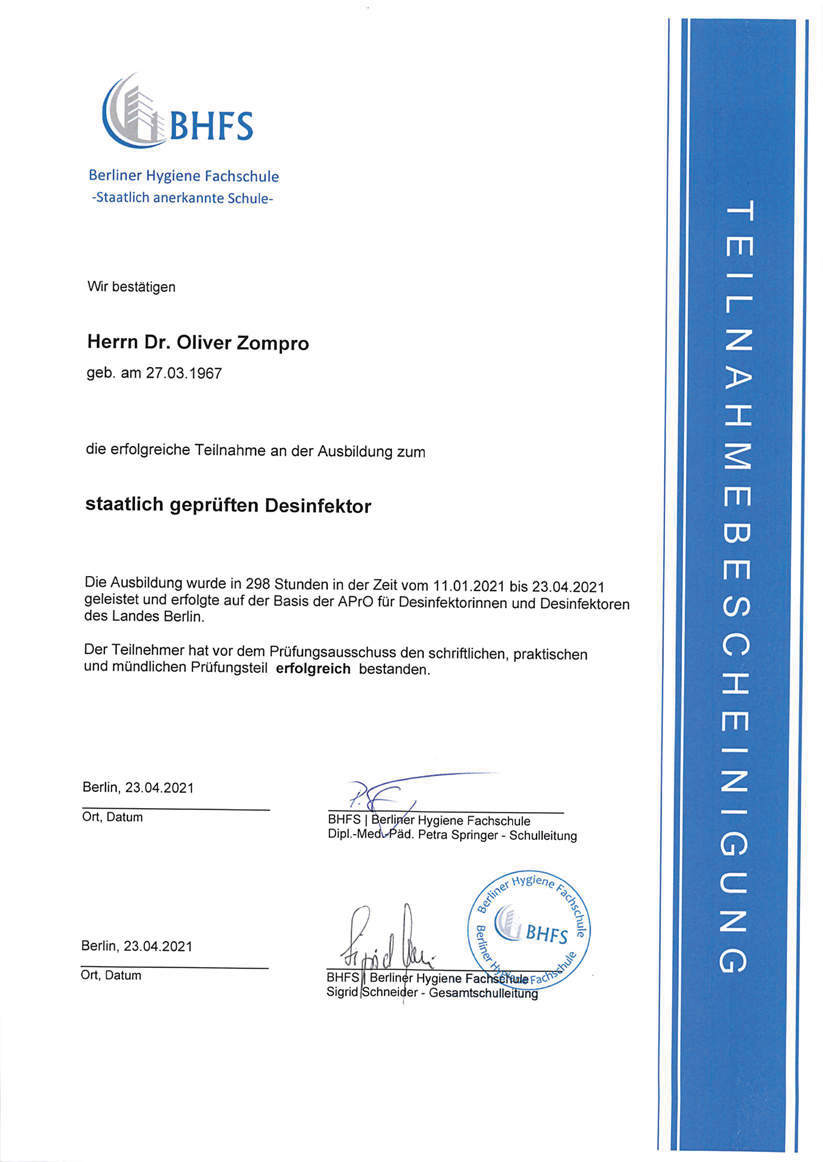

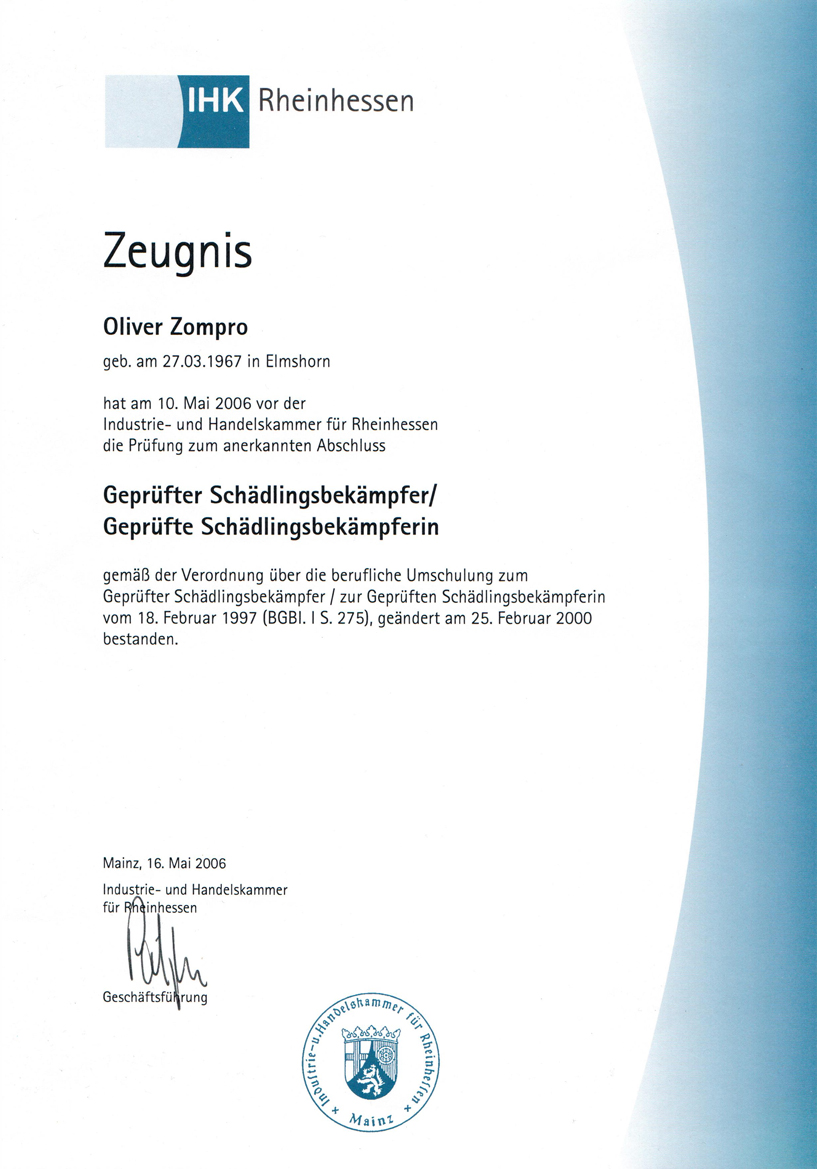
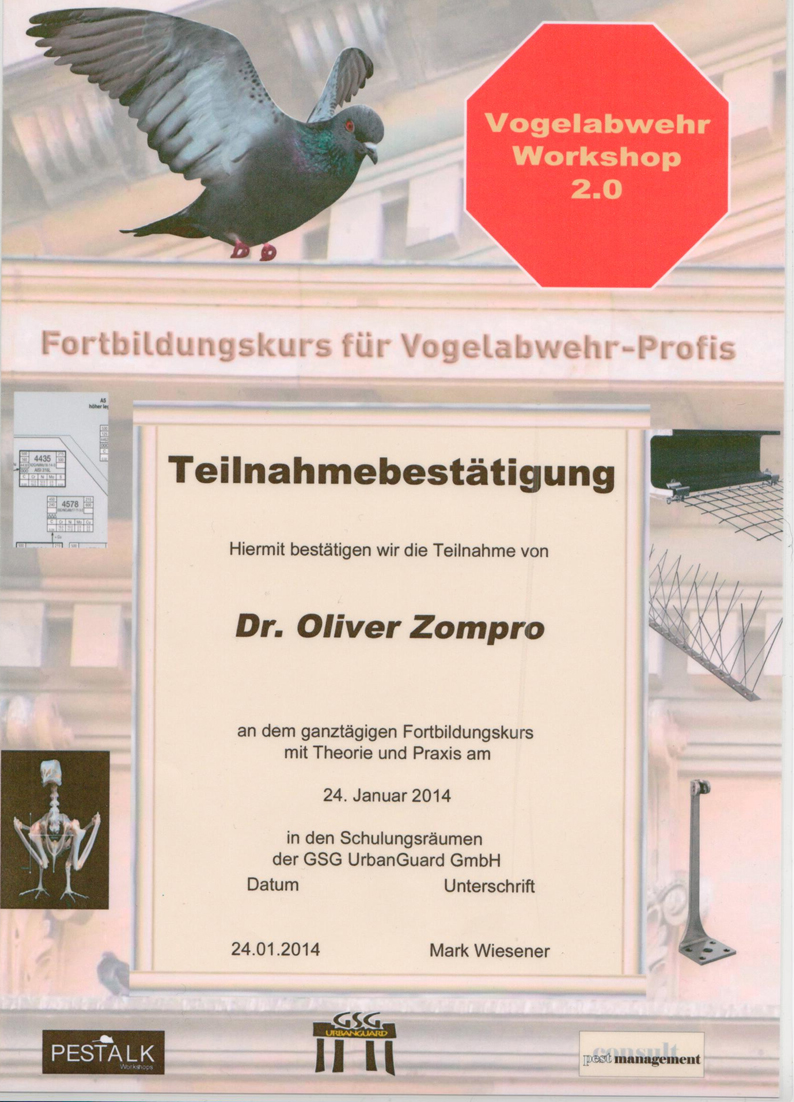
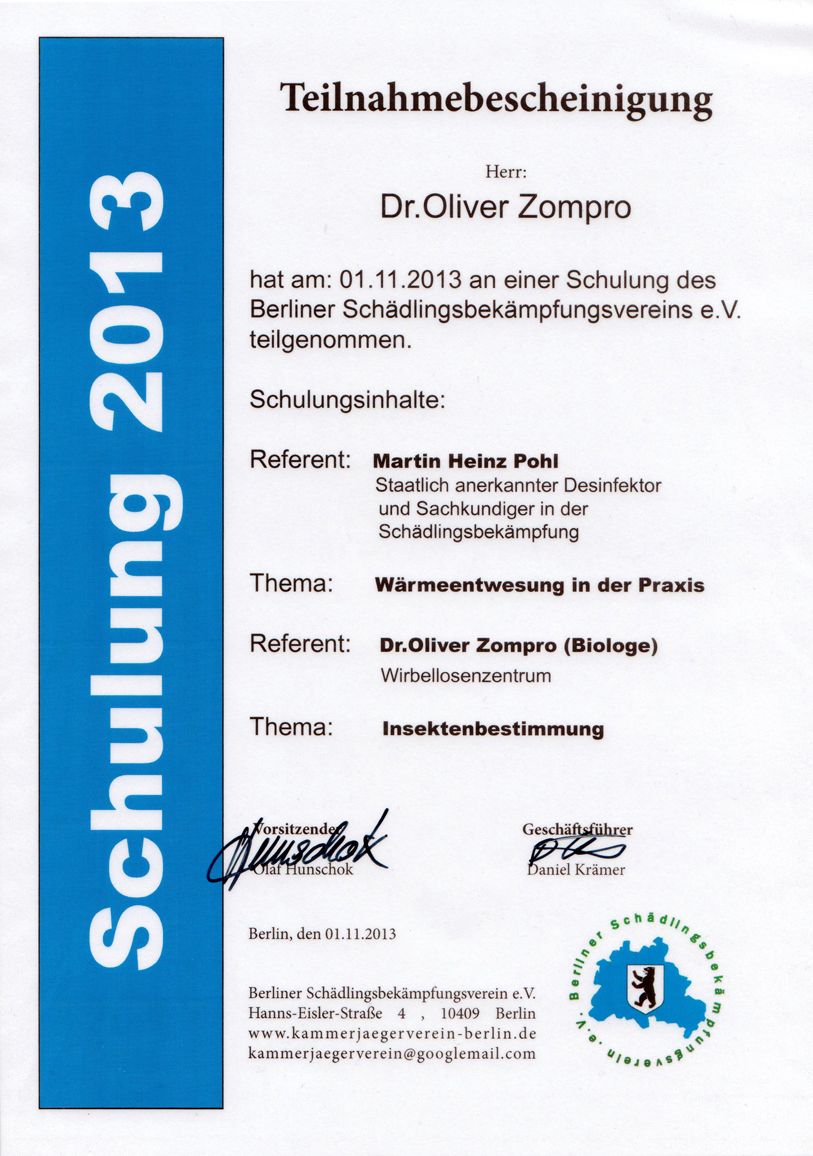

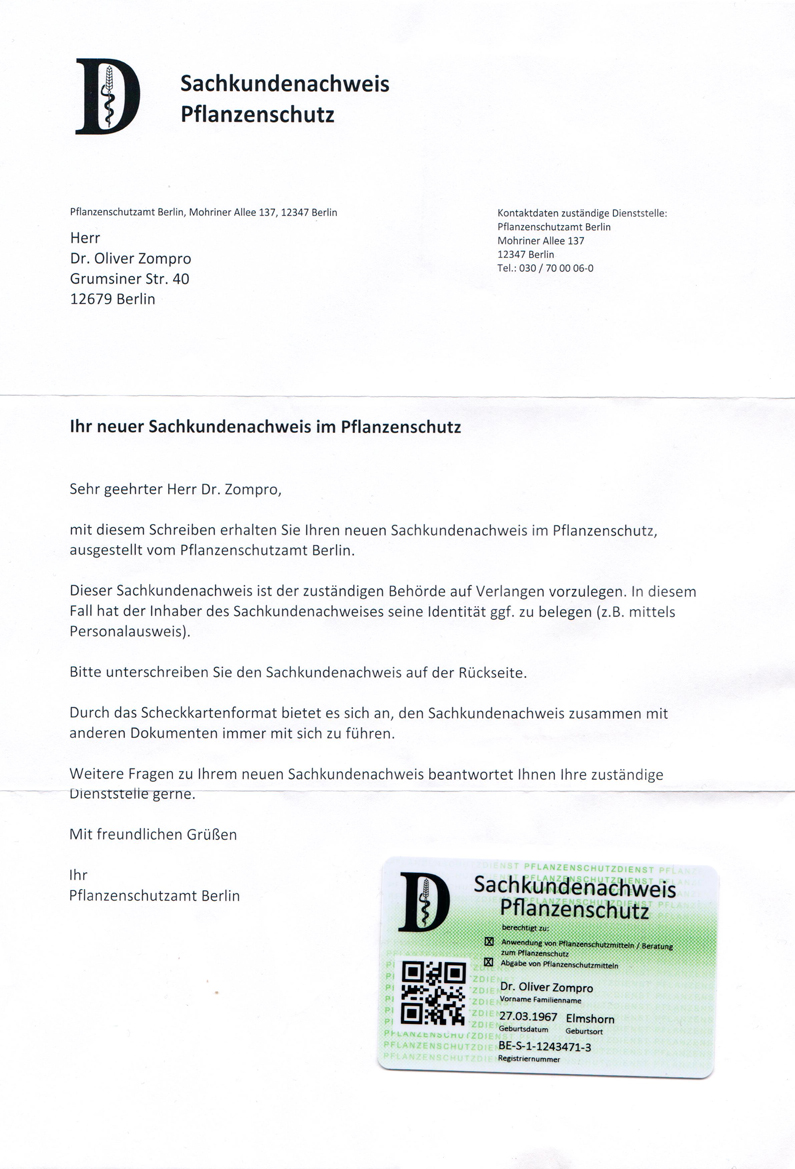
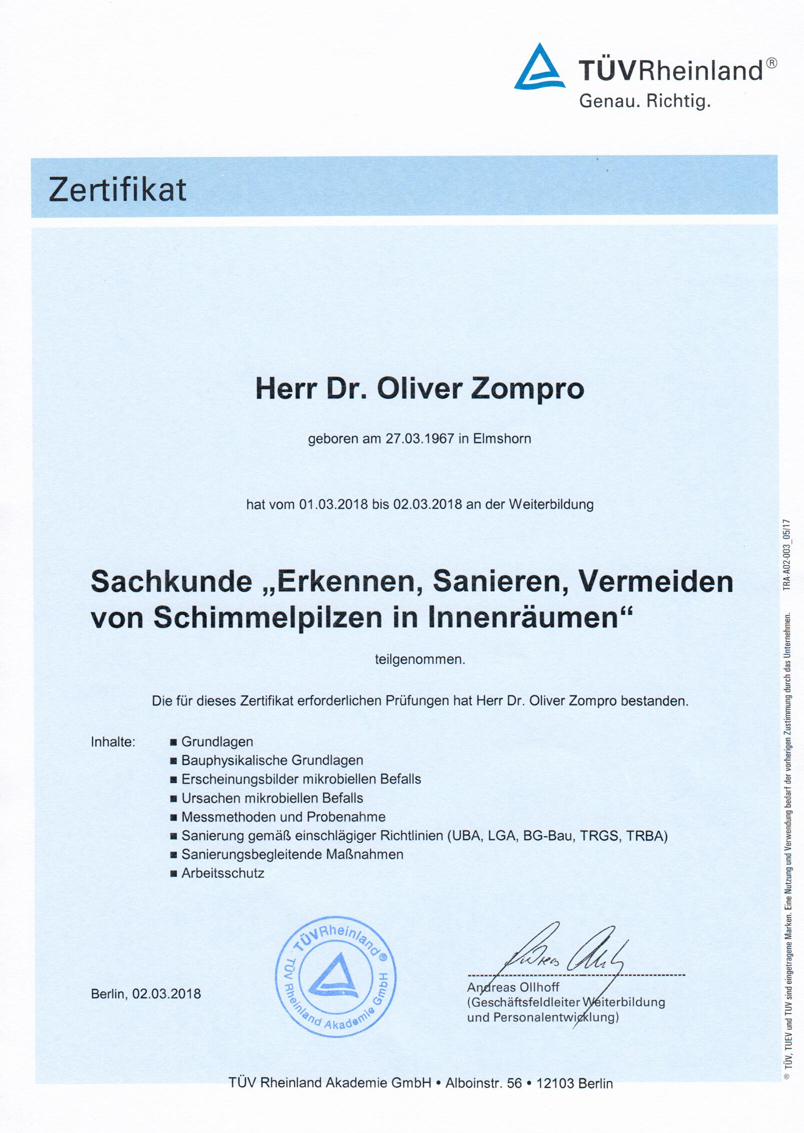

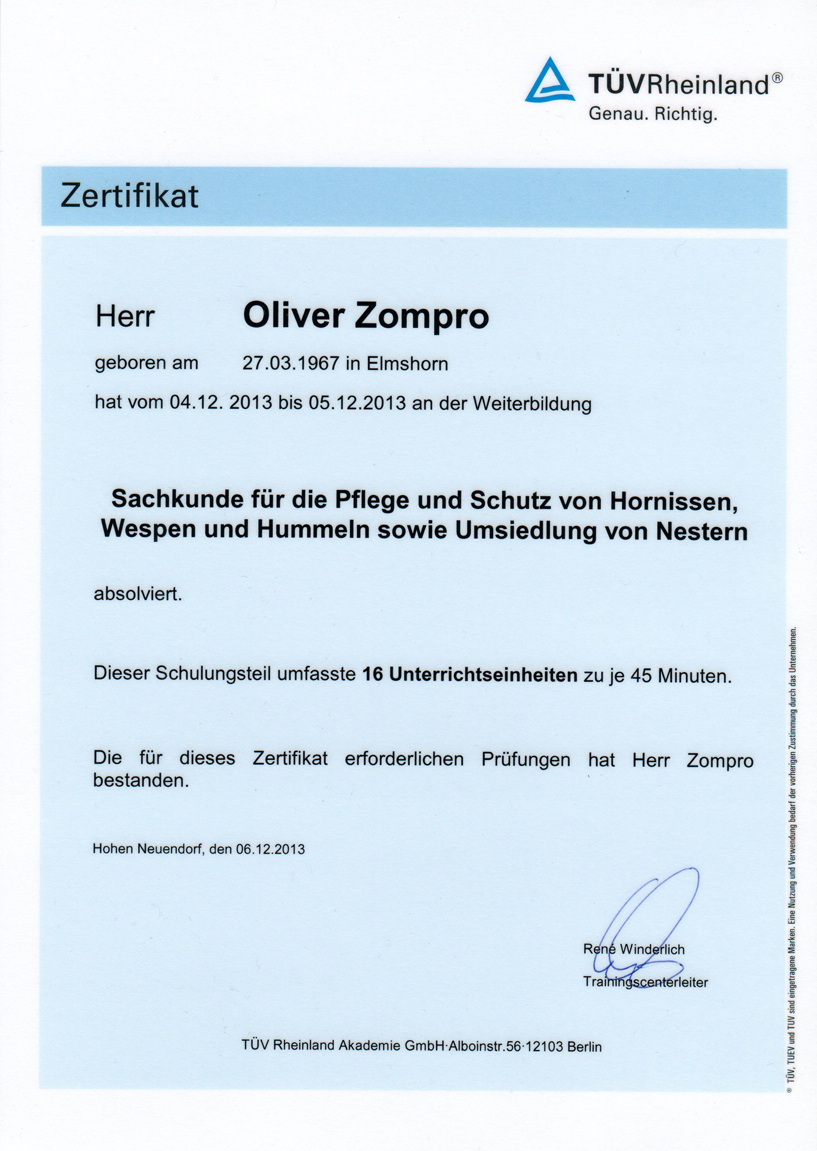

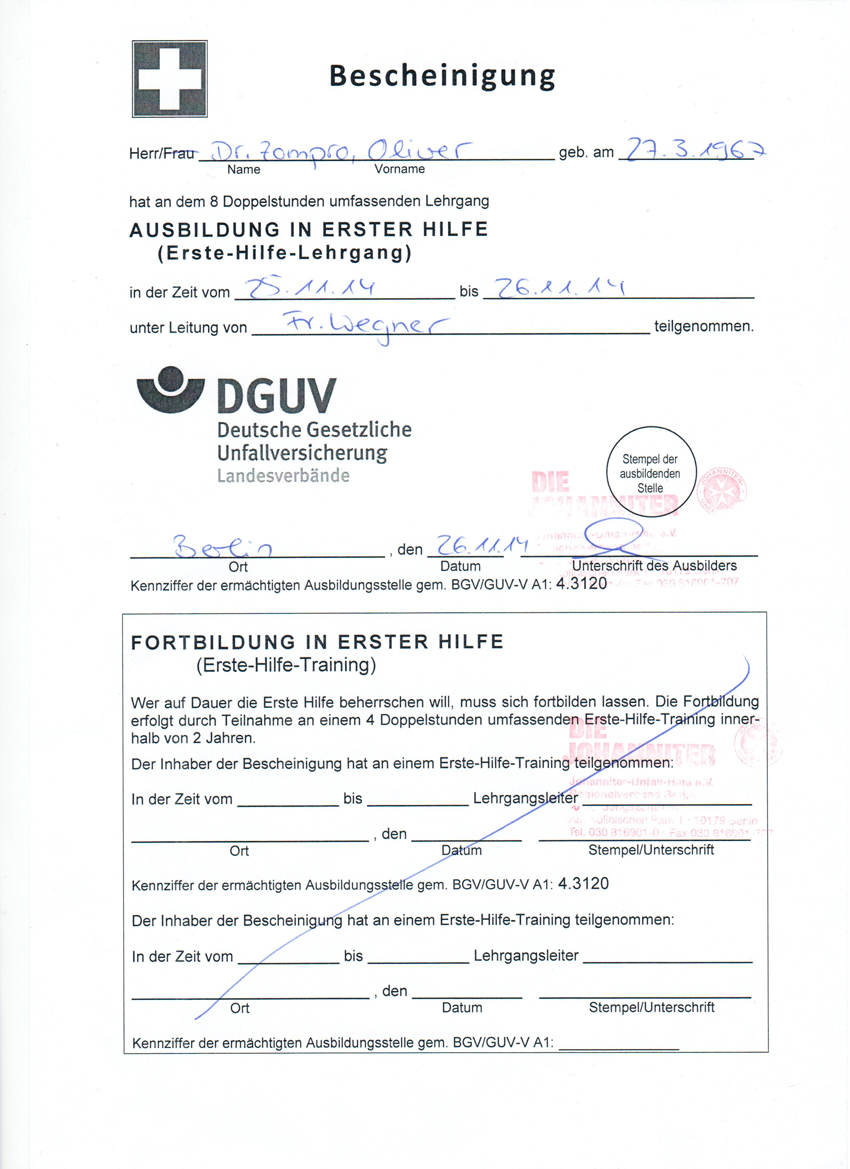
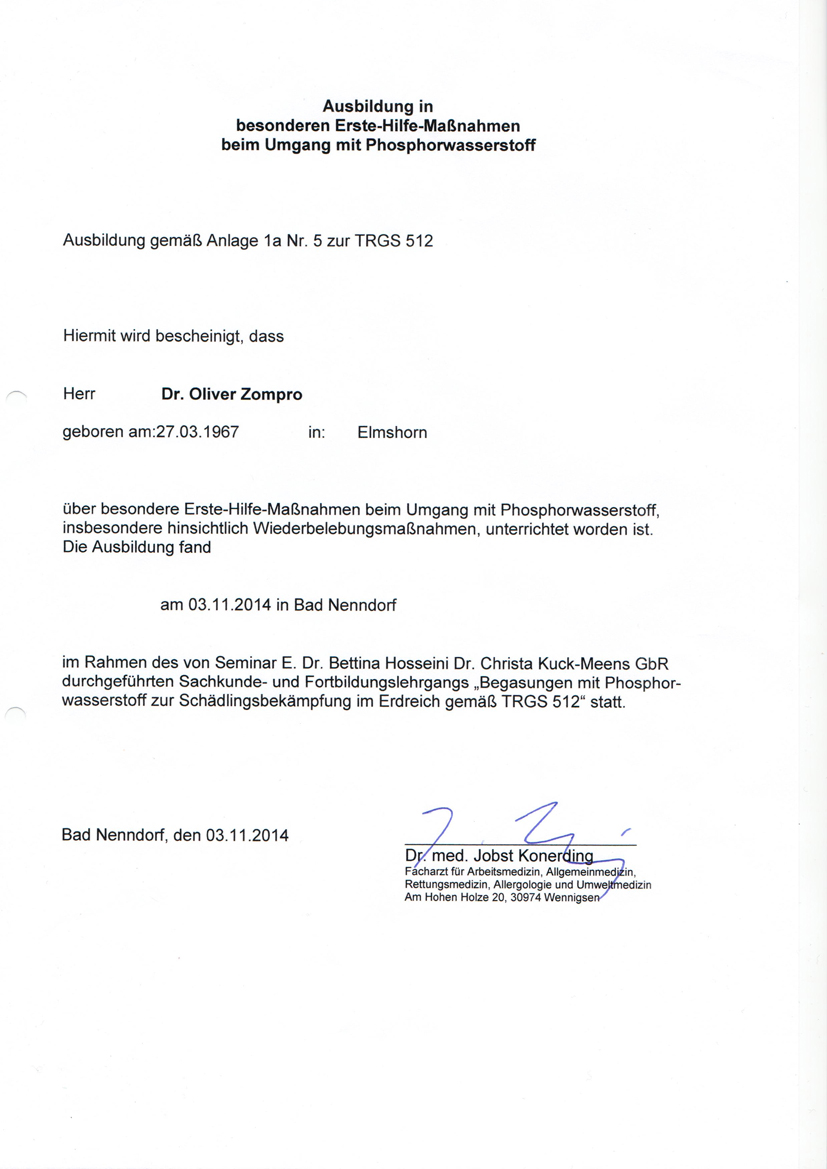
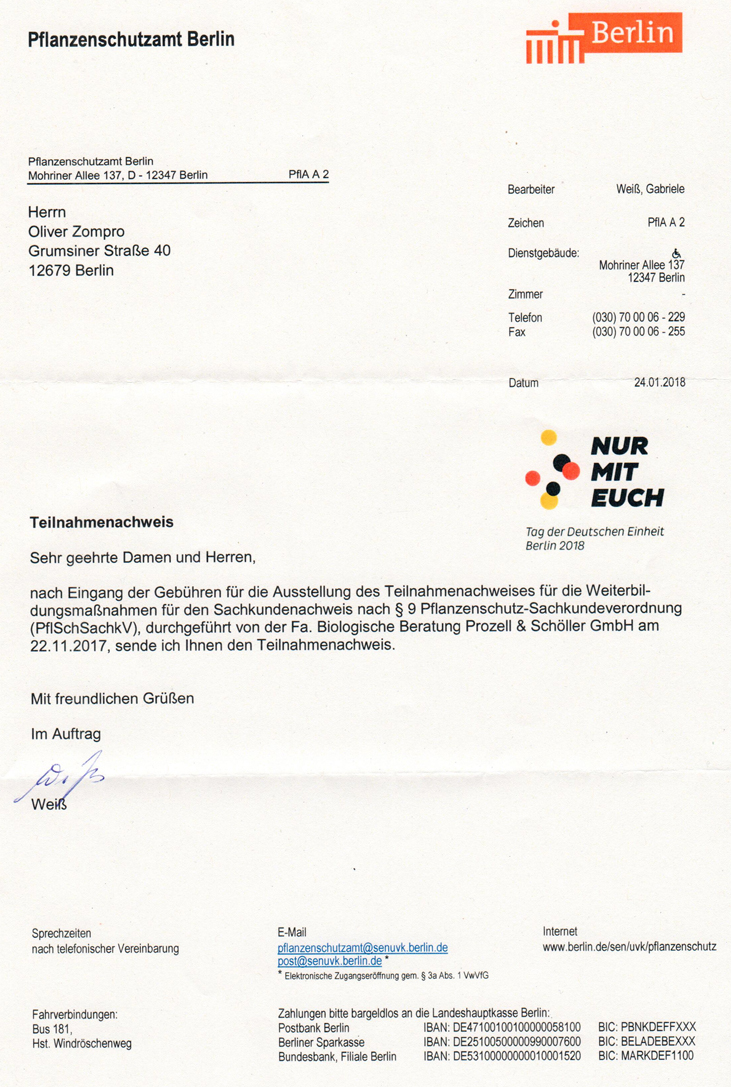
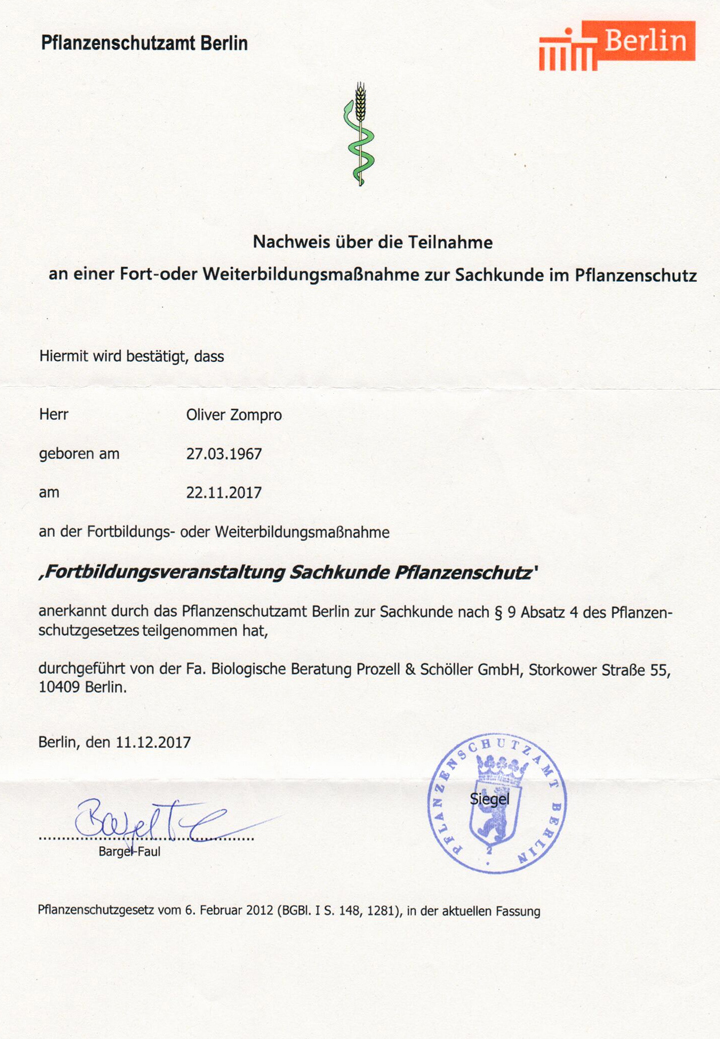
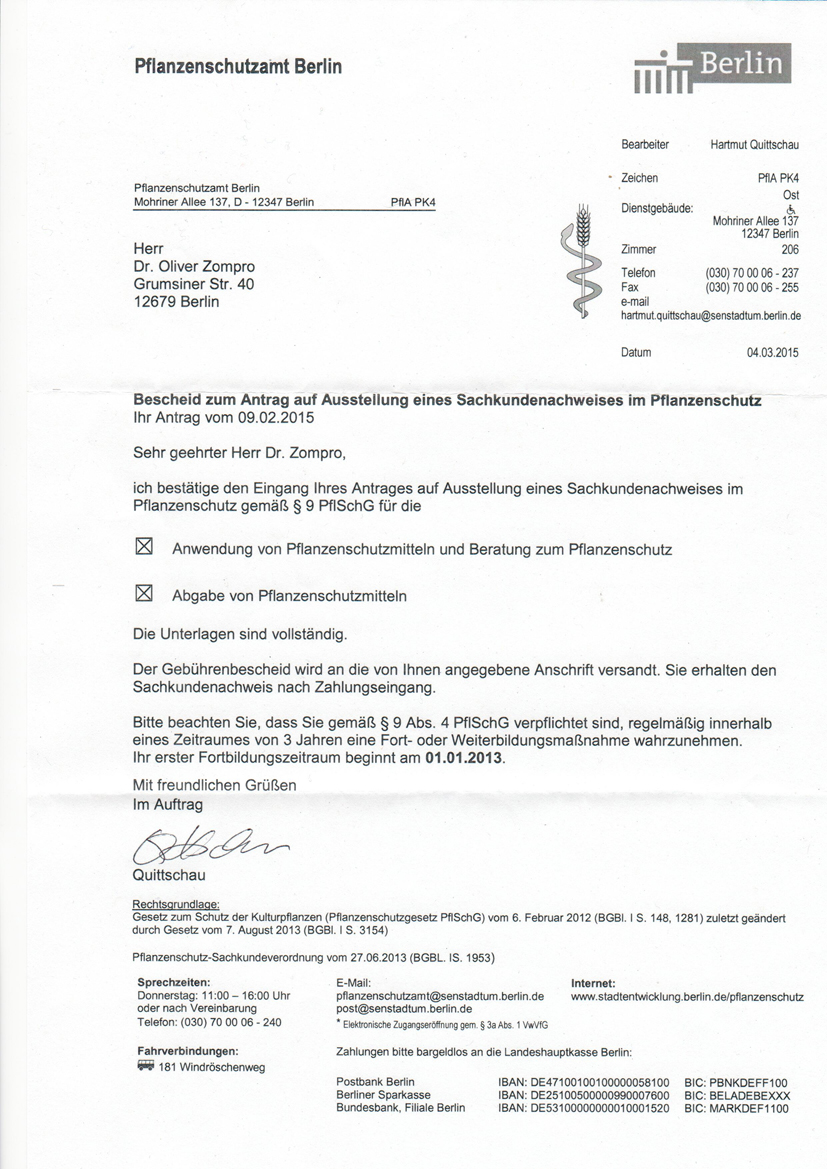
Seite 2 von 2
